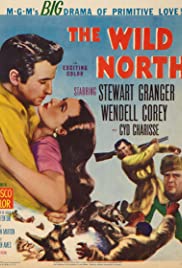
THE WILD NORTH
US, 1952, 97 minutes, Colour.
Stewart Granger, Wendell Corey, Cyd Charisse.
Directed by Andrew Marton.
The Wild North is an action thriller from MGM in the early 50s, utilising its stars from its bigger-budget films including Stewart Granger who was making at this time films like King Solomon’s Mines, The Prisoner of Zenda, Scaramouche. Cyd Charisse was on loan from her musicals including Singin’ in the Rain and The Bandwagon. Wendell Corey was always a sturdy presence and portrays the constable. Granger portrays a trapper who is accused of a crime and is on the run in the wild north. Cyd Charisse is an Indian girl.
The film was directed by Andrew Marton, better known as a second-unit director on such action films as Ben Hur, Cleopatra, Fall of the Roman Empire, Kelly’s Heroes. He made a few brief action films like this one including Men of the Fighting Lady and Green Fire with Stewart Granger and Grace Kelly.
1. How pleasing an adventure? A conventional adventure film of the fifties?
2. The use of colour? Canada and its wild northern landscapes, the atmosphere of the North?
3. Vincent as the focus of the film and of interests Stewart Granger and his particular style, his work an a trapper, the introduction to him with the man who minded his boat, his easygoing nature, spirit of adventure, enjoyment of the town and of drinking? His friendship with the girl, the fight with Brodie? His decision to take her with him and the quality of their relationship? How credible an adventurer of the North? Could audiences identity with him and sympathise with him?
4. The introduction of Brodie, the violence of the fight, his apologies and accompanying them? Brodie and the circumstances in people's memories? The importance of our not being shown his death? But its suggestion? The consequences of Vincent not telling the truth about Brodie’s death? The hiding of the body and his goods? Should Vincent have done this or not? What were his reasons for not telling the police, his expectations of the administration of justice?
5. How attractive was the girl, her work in the saloon, her Indian heritage and wanting to return? Her support of Vincent? Her helping him in concealing the death? Her impact on the Mountie when he visited the home? Her being there on their return and the support to Vincent? A conventional character. ren.lism of a heroine?
6. The characterization of the Mountie? His receiving his commission to hunt Vincent, his not believing the circumstantial evidence? The picture of him doing his job, inquiring from the storekeeper, from the girl also? The determination in his pursuit, the confrontation with Vincent? The irony of this confrontation in the context of the death of the priest? How strong was his character, his loneliness and sons, of being alone?
7. How well did the screenplay work out the dramatics of the confrontation, their mutual help, their mutual hostility? The effect of the snow and the winter, the terrain? The use and symbolism of the handcuffs? One controlling the other, threats, possibility of mutual killing? The nature of the bond between them? The encountering of dangers, Vincent deliberately losing the way? The Mountie's injuries the confrontation of the wolves and his fear? The reversal of roles and the chaining of the Mountie to the sled? Vincent and his decision to save him? The pathos of the Mounties helplessness?
8. The importance of the scenes where Vincent and the girl tried to rehabilitate the Mountie? The help of the storekeeper? The decision to shoot the rapids and the effect on the Mountie? How credible was this therapy?
9. The brief court sequences, the Mountie’s story and his not telling the exact truth? Was it important that the truth be told or not? Morality and its not being equated with strict justice?
10. The quality of the film an an adventure, adventure situations and crises? Audience interest in the decisions and the values behind the decisions?